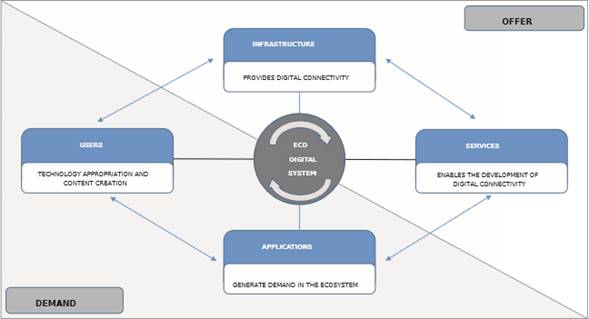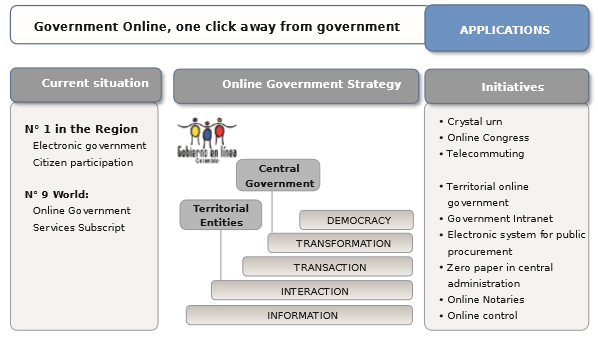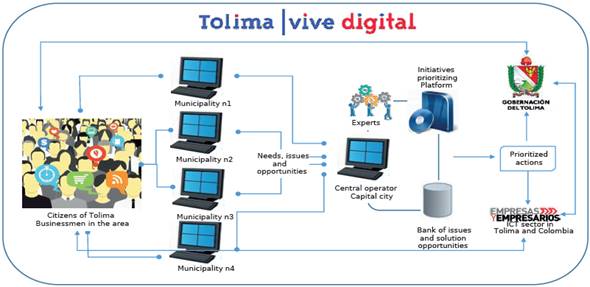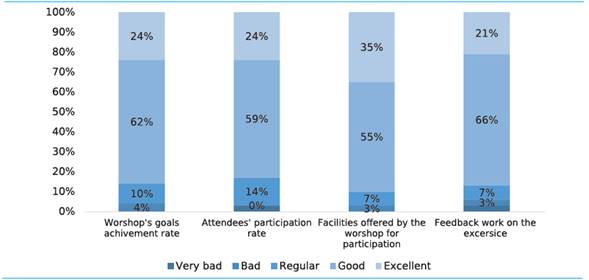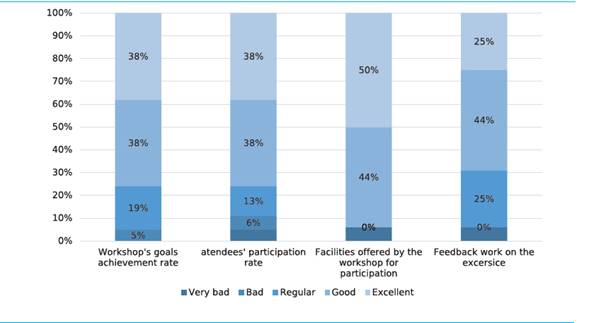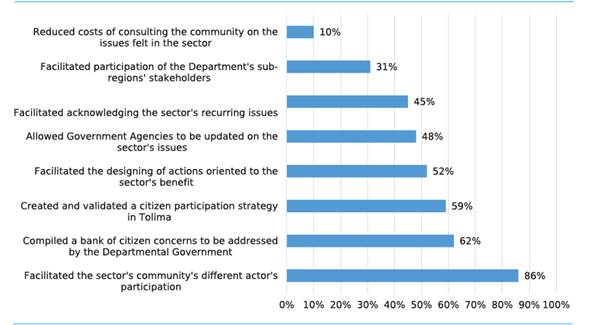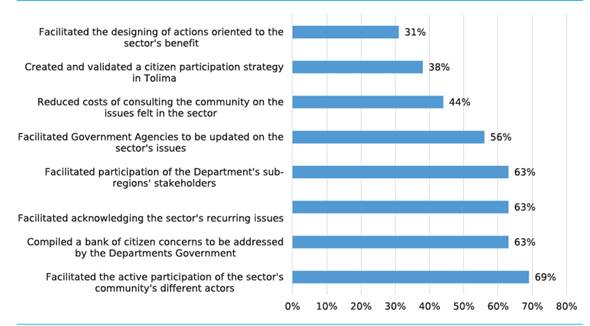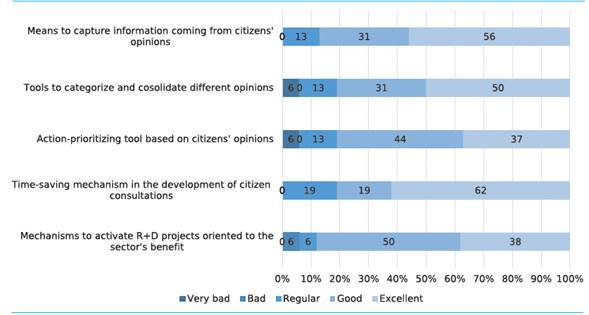1. Introduction
Currently, the use of the Internet in public administration has become consolidated and is seen by academics and empiricists as a means to innovate the processes and services that each government provides to its citizens (Alzahrani, Al-Karaghouli and Weerakkody, 2017; Criado and Gil-Garcia, 2013). Undoubtedly, the adoption of the e-government system by the public administration has created a new relationship between citizens and government (Sour-Vargas, 2007). As a result of the foregoing, one of the great challenges faced by governments nowadays is how to appropriate and take advantage of the Internet and Information and Communication Technologies (ICT) to create new and effective information and communication channels with their citizens (García and García Jiménez, 2013; Meijer, Curtin and Hillebrandt, 2012), and even more, to allow them to participate in the design of public policies (Criado and Gil-García, 2013; Linders, 2012; Wijnhoven, Ehrenhard and Kuhn, 2015). The evolution of this new form of public administration has given rise to innovative approaches such as “gobierno abierto” (open government) and “gobierno 2.0” (government 2.0), which have been transforming the delivery of public services in various parts of the world (Salem and Jarrar, 2013).
Open government refers to the presence of more transparent, efficient and accountable public administrations, whose essential components are the participation and collaboration of governed citizens (Purón-Cid and Gil-García, 2012). On the other hand, operating under environments such as Web 2.0 has enabled the emergence of the so-called Government 2.0 that has empowered citizens to interact and collaborate among themselves as content creators, which not only informs them, but also turns them into providers of information (Karkin, 2013) at opinion generators for the design of public policies (Linders, 2012)or into actors of public control of the rulers’ actions (Mergel, 2013; Picazo-Vela, Fernandez-Haddad and Luna-Reyes, 2016).
To the extent that ICTs have broadened the spectrum of action of public administration, so have these, in the same way, motivated the interest of society in general, and academics in particular, to establish and assess the real contributions to the effectiveness of the governments that integrate them into their administration. In this respect, several studies have taken place, such as that carried out by Criado and Gil-García (2013), which aimed to describe the process of implementating ICT into government functions; Vercelli (2013), in turn, became interested in describing the ways of citizen participation through ICT, and along the same lines, Pareja and Echeverría (2014) were interested in studying the role played by new technologies in the construction of public opinion. On the other hand, Mergel (2013) focused on evaluating the impact of the initiatives that integrate ICTs in the participation and collaboration of citizens, while pointing out that there is still little evidence to actively measure the impact of the digital interactions derived between government and citizens.
Considering the foregoing, this paper analyses the Tolima Vive Digital (TVD) project in Colombia, a public intervention Program based on the principles of Open Government. In particular, it was interesting to study the results of the implementation of its first component: the use of the Ethos digital ethnographic platform as a means for the design and execution of public policies aimed at strengthening the productive apparatus within the tourism and cultural industry of the Tolima region.
This study is complementary to the evaluation process that the national Government carried out through the “Departamento Nacional de Planeación”-DNP (National Department of Planning) and the “Sistema Nacional de Evaluación y Gestión de Resultados”- Sinergia (National System for Evaluation and Management of Results), consulting other regions of the country on three other components of the Vive Digital Plan: digital kiosks, digital Points and digital Homes (DNP, 2015), as well as the initial work carried out by Mora (2012) with the executive assessment of the Vive Digital Colombia Plan. This paper is structured from the frame of reference, the methodology used, the results of the evaluation and its discussion, to the presentation of conclusions.
2. Reference framework
2.1. Traditional public policy design versus alternative design
In the more traditional approach to public policy design, professional experts have been questioned for serving their own interests and those of elites seeking to maintain their dominance over the rest of society (Fischer, 1993). Moreover, the theory of public election (Buchanan and Tollison, 1984) has developed much of its conceptual framework based on the assumption or premise, without further questioning, that political decisions made by agents (e.g. experts and professionals) in charge of state management protect their individual interests with the aim of having themselves re-elected or remaining in positions of power. In this way, those who are under the control of the state are subject to these interests, who in turn may or may not proactively reinforce this practice through clientelism.
In response to this strong criticism and its practical manifestations, several social scientists have attempted to advance on a collaborative alternative to this traditional form of generation. Those who have promoted the participatory action research model (PAR) or simply participatory research (PR) are particularly important (Koch and Kralik, 2009) (Fals-Borda and Rahman, 1991; Koirala-Azad, 2017). PAR builds on the efforts of citizens’ groups to both expand their access to information produced by scientists and to systematize their own local knowledge (Fischer, 2000). Hence, they are an effort of democratic collaboration between agencies, state agents and citizens.
2.2 Open government: transparency and timeliness in PAR processes
The term open government has positioned itself as a new articulating axis of efforts to improve government capacities and modernize public administrations under the principles of transparency and openness, participation and collaboration (Ramírez-Alujas, 2011). The idea of achieving an open e-government is nowadays seen as an alternative that will lead to the construction of better forms of government in the digital age, seeking to make them more transparent, reliable, participatory and collaborative (Vercelli, 2013). It is a format that emerges, therefore, as a response to a specific concern of governments to counteract the more traditional top-down practices of public policy design and implementation mentioned above. E-government is driven in particular by the use of ICT to provide effective delivery of government services and information to citizens, businesses and other government agencies (Alzahrani et al., 2017).
In the case of open government, as Heckmann (2011) sees it, one of its purposes is to improve transparency and accountability in all public affairs, and therefore, as Wijnhoven et al. (2015) allude, it can improve opportunities for citizens to participate in public policy making. On the other hand, for the Organization for Economic Co-operation and Development (OECD), the term open government has evolved over time from being a transparent, responsive, accountable, accessible and responsive public administration (2006) to an approach where it is seen as a platform to find ways for the government to work with society to co-create public value (Ramírez-Alujas, 2014, 2011).
Furthermore, e-government has to do with citizen participation through citizen consultation platforms, which enable an active role for them in the design and formulation of public policies; it also includes the implementation of active listening mechanisms and two-way channels, promotion of spaces for citizen initiatives, digital services, online petitions, and platforms for collaborative work. In these mechanisms, there is room for initiatives of co-design, co-creation and co-production of services, open innovation and collective intelligence applied to public management and public-private/public-social partnerships.
2.3 Citizen participation
In terms of openness to citizenship, the possible scopes of citizens’ participation in open government are citizen ideation and innovation, which aim to gather external knowledge, mostly from citizens, to improve the achievements by the public administration (Hilgers, 2012). Within this opening lies the so-called citizen sourcing on the one hand (Nam, 2012; Wijnhoven et al., 2015) and the so-called urban observatories on the other (Valenzuela-Montes and Carvalho-Cortes-Silva, 2015).
Citizen sourcing’s aim is to have citizens support daily public administrative tasks but does not involve innovation or new ideas, and finely the collaborative democracy that seeks answers to the normative questions for the future development of society (Wijnhoven et al., 2015). As regards urban observatories, these are related to the capacity to promote citizen participation by using Geographic Information Technologies (GIT) for the purpose of analyzing the use that citizens make of urban phenomena, policies, plans and projects (Valenzuela-Montes and Carvalho-Cortes-Silva, 2015).
Based on the aforementioned, the importance and depth of the active and interactive role of citizens in the development of the open public administration becomes evident (García and García Jiménez, 2013), so that they are not limited to observing only. Thus, with a real opening of open government the citizen could participate with the government from three areas (Cortés-Sánchez, Cardona and Wong, 2013): e-enabling which consists on using technology for citizen participation; the second is e-engaging which is the use of technology to engage the citizenry, and finally e-empowering that involves the use of technology to empower the citizenry. Any of these three types of participation implies the government being willing to provide opportunities for citizens to participate in the design of public policies, aside from facilitating social innovation processes.
2.4 The integration of ICTs for government management in Colombia
In Colombia, there are initiatives aimed at promoting both open and electronic government. Article 270 of the recent Political Constitution of 1991, empowers citizens to take an active part in the control of public management by establishing: “An Act shall organize the forms and systems of citizen participation making it possible to oversee the public management completed at the various administrative levels and their results”. This regulation grants Colombian citizens the right to know, participate and control government processes. On the other hand, since 2000, Colombia has been carrying out a campaign to implement e-government in order to contribute to improving the efficiency and transparency of the Colombian State through the gradual construction of an online government.
In the case of Colombia, online government appears mainly in the following modalities (Riascos Erazo, Martínez Giordano and Solano Rodríguez, 2008): a) Government-to-Citizen (G2C), where initiatives aimed at delivering administrative, information and/or transaction products and/or services to citizens by the State are found; b) Government-to-Business (G2B), which comprise initiatives aimed at delivering administrative, information and/or transaction products and/or services information to businesses by the State; and c) Government-to-Government (G2G), with initiatives aimed at meeting coordination requirements between the different institutions of the national and territorial government. The citizen-to-government (C2G) modality is present to a lesser extent, namely, wherein the citizen can be not only a consumer of information, but also a producer of it through ICTs.
Among the highly positioned initiatives in Colombians lies the digital platform “Urna de Cristal” (Urn of Crystal (www.urnadecristal.gov.co); created in 2010 as a multi-channel mechanism for citizen participation, where the user has the possibility to: a) know the results, progress and initiatives of the Government; b) forward their concerns and proposals; c) interact and learn from state management.
Other outstanding open government initiatives in Colombia are: the “Alianza Gobierno Abierto” Program -AGA (Open Government Alliance), which began in 2011 with the participation of eight countries and has already brought together more than 60 countries around the world hitherto, Colombia amongst them, all of which are committed to “improving government performance, promoting effective participation and improving governments’ responsiveness to their citizens through the implementation of strategies on transparency, access to information, citizen participation and the use of new technologies that generate concrete and visible change” (AGA, 2017); and the “Mi Medellín” (My Medellín) Program in Antioquia, which has become a channel of connection between citizens and the Local Administration, thus motivating the prioritization of resources and the execution of budgets based on the ideas and proposals stemming from citizens (Ruta Medellín, 2015).
2.5 The Vive Digital Program in Colombia
The Vive Digital (VD) program was the technology plan created by the Colombian Government for the 2010-2014 four-year period, to enable the country to make a technological leap forward by means of the massive usage of the Internet and developing the national digital ecosystem. Its design was based on the experience of other nations such as Chile and India, as well as on the reports of the World Economic Forum (Kim, Kelly and Raja, 2010), which showed the direct correlation between Internet penetration, ICT appropriation, job creation and poverty reduction. Other countries’ previous experiences in the massification of the Internet showed certain key factors for its success, among them: existence of a country vision, existence of a regulatory framework, public financial leverage, stimulation of demand and large deployment of infrastructure to facilitate the increase of network coverage (MINTIC, 2010).
In the case of Colombia, although increasing Internet penetration rates have been reported since 2004, they were still low in 2010; the Internet penetration rate among the inhabitants did not exceed 2.5% on mobile Internet and was close to only 5.5% on fixed Internet (MINTIC, 2010). This reality showed Colombia lagging behind other countries in the Latin American region such as Chile, Mexico and Brazil. With all these arguments, the VD program was launched at the national level as a digital ecosystem as seen in Figures 1 and 2, which was remarkably successful with respect to the set goals, achieving its execution in practically the entire national territory (1,222 municipalities) by 2014, with a cumulative number of direct beneficiaries that exceeded 1.5 million people, including public officials and citizens certified in the use of ICT, the vast majority of the latter coming from disadvantaged groups.
The Tolima region was among the 25 departments of Colombia that benefited from the VD program, through the project called Tolima Vive Digital (TVD). This project was formulated considering the low supply of newfangled digital content aimed at promoting the tourism sector in the Region, and the insufficient access and exploitation of ICT tools by the overall community. To address these issues, the TVD project was implemented between June 2013 and July 2014 in order to help promote a citizen-centered information society in Tolima, where citizens are able to create, consult, use and share information and knowledge to promote employment, sustainable development and improved quality of life.
In its execution, the TVD project was structured in four components, the first whereof was related to the implementation of a Digital Platform for Citizenry Activation (PAC by its acronym in Spanish) in tourism and culture, based on ethnographic processes, which sought to generate innovation opportunities for the development of new digital content and for the emergence entrepreneurship actions, both for the tourism sector and for the ICT sector in Tolima.
3. Methodology
The TVD project’s first component’s impact assessment - the Ethos digital ethnographic platform as a means for the design and execution of public policies aimed at strengthening the productive apparatus in the region’s tourism and cultural industry - was carried out on the basis of the methodological guidelines recommended for evaluative research (Uribe Correa, Puerta Zapata and Restrepo Gómez, 1996), which proposes that once the preparation stage of the evaluation process has been completed (with the design and validation of the questionnaires through pilot tests), the evaluation process should be carried out, which may be qualitative and/or quantitative.
The evaluation process was structured to address the following questions:
What is the perception of the first component’s beneficiaries and facilitator-experts regarding the quality of the training workshop held?
What is the perception of the first component’s beneficiaries and facilitator-experts regarding the benefits expected from the workshop?
What is the perception of the first component’s accompanying experts regarding the benefits expected from the ethos platform?
To answer these questions, the assessment process was expedited through the following stages:
Application of instruments. Twenty-nine beneficiaries linked to the region’s tourism and culture sector (out of 175 registered as participants) and 16 facilitators-experts in the operation of the Ethos platform (out of 27 registered as collaborators) were consulted through a questionnaire. Likewise, Interviews were also conducted with three key actors within the TVD process.
Information processing. The information obtained was processed with descriptive statistical tools, and the opinions of the interviews were interpreted from the technical foundations of discourse analysis. The internal consistency of the consultation instrument was checked (Cronbach’s alpha acceptable α > 0.7) and validated the presence of stakeholders representing each group thereof for the study.
Results Analysis. The opinions obtained by questionnaires were oriented towards establishing a rating for the results of the activities carried out and the expected benefits, while the opinions obtained through the interviews were oriented towards an assessment of the impacts in scientific-technological and socio-cultural terms.
4. Results and discussion
4.1 Results of the TVD Project’s first component
Figure 3 schematically summarizes the enriched and dynamic loop of interaction enabled by the ethos platform between ICT solutions buyers and sellers and the government of the Tolima region.
As shown in Figure 3, the enriched and dynamic loop of interaction between stakeholders facilitated several outcomes particularly valuable to the government administration in place at the time, including the following:
Recognition of Tolima’s touristic potential
Recognition of the possibilities offered by ICT under web 2.0
The creation of a specialized technological platform to facilitate multi-user and online participation in popular consultations (Ethos)
The consolidation of a bank of initiatives to improve and change the tourism and culture sector in the region, as shown in Tables 1 and 2.
The generation of mobile applications (Apps) and websites, containing useful information for the tourism and culture industry, as seen on Table 3.
The activation of work units that led to the emergence of a local cluster for the digital industry in Tolima, as Table 4 shows.
Table 1 List of categories hosting the initiatives generated through Ethos
| Categories | |
|---|---|
| Pricing | Products and services |
| Promotion and dissemination | Base infrastructure |
| Safety and security | Incentives, support and recognition |
| Quality | Environment |
| Technological Infrastructure | Loyalty |
| Commercial Infrastructure | Integration |
| Education and training | Historical heritage |
| Cultural identity | Coverage and inclusion |
| Guidance and advicing | Projects |
| Legalization | |
Source: Author’s own elaboration based on the reports provided by the TVD Project
Table 2 Consolidation of initiatives generated through Ethos
| Prioritized sectors | Issues | Opportunities | Needs |
|---|---|---|---|
| Tourism | 47 | 63 | 55 |
| Culture | 8 | 7 | 16 |
| Tourism and culture | 97 | 103 | 149 |
| Total | 152 | 173 | 220 |
Source: Author’s own elaboration based on the TVD Project reports.
Table 3 Technological solutions with digital content generated for tourism - TVD Project
| Content orientation areas | Mobile applications (App) | Websites |
|---|---|---|
| Culture and gastronomy | 8 | 10 |
| Sport and recreation | 6 | 4 |
| City and mobility | 3 | 3 |
| Conservation and environment | 3 | 1 |
| Business development | 0 | 3 |
| Other topics | 3 | 6 |
| Total | 23 | 27 |
Source: Author’s own elaboration based on the TVD Project reports.
Table 4 Companies and alliances from the ICT sector, participating in the TVD project
| Participants | Quantity | Local operation | Operation beyond the local |
|---|---|---|---|
| Entrepreneurs | 25 | 20 | 5 |
| Unique companies | 7 | 5 | 2 |
| Business Alliances | 1 | 1 | 0 |
| Total | 33 | 26 | 7 |
Source: Author’s own elaboration based on the TVD Project reports.
4.2 Assessment of the Ethos platform’s results
The assessment of the results was performed based on the opinion provided by the process’s beneficiaries and facilitators, compared to the two central activities that took place: the workshop to identify the needs and opportunities of the sector, and the interaction between actors through the use of the Ethos platform.
The workshop to “Identify needs and opportunities in the sector” was rated from good to excellent by the respondents, whom in this case were tourism sector actors, facilitators and experts. This high rating suggests that the workshops met their intended purposes, facilitating the active participation of stakeholders from the tourism and culture sector in the region, as presented in Figure 4a (opinion of stakeholders from the tourism sector) and Figure 4b (opinion of facilitators and experts).
Regarding the benefits generated by the workshops (nine workshops in total, held in as many municipalities), most of the beneficiaries consulted agreed that these facilitated the active participation of the different actors from the sector’s community and enabled the compilation of a citizen concerns bank to be addressed by the Departmental government, as Figure 5 displays. Notwithstanding, this same consensus is not evident in terms of facilitating the participation of actors from the different sub-regions of the Department, nor in the costs of consultation on issues felt in the sector.
Continuing with the benefits generated by the workshops in the consultation carried out with facilitators and experts, the latter as well as the beneficiaries, agree that the workshops facilitated the active participation of the sector’s community’s different actors, and allowed to compile of a bank of citizen concerns to be attended by the Departmental government, as Figure 6 shows. Nonetheless, this group does not present the same appreciation regarding the issue of costs and facilitating the participation of actors from the different sub-regions of the Department, since the lowest ratings lie in the concept “Facilitated the design of actions oriented to the benefit of the sector” and “Created and validated a strategy of citizen participation in Tolima” according to the experts.
On the other hand, as seen in Figure 7, the Ethos ethnographic platform was rated by the consulted experts, with an overall rating above four on a scale from one to five, five being the best. These highlighted the contribution to saving time in the carrying out of citizen consultations (62%) and the ease it offers for the capturing information from citizen opinions (56%).
4.3 Assessment of the impacts generated through the Ethos platform
The qualitative analysis of the results stemming from the application of the Ethos tool as an ICT tool for citizen participation in the design of regional public policies in Colombia was carried out on the basis of the interviewees’ opinions, whose profile obeyed to people representing the process (representative of the national co-financing entity, representative of the regional executing entity of the project and representative of the entity developing the Ethos platform), considering its impacts through two dimensions: scientific-technological and socio-cultural. Some of the main views on the perceived impacts of ICT as a tool in public policies design are described below.
In science and technology matters, the results coming from the interviewees’ opinions showed impacts in the generation of new knowledge about the touristic and cultural destinations of the Region, thus contributing to social innovation, the transferring of information and the generation of cooperation processes between the academy, sector ICT and government. To the interviewees, the Ethos platform represented an innovative proposal for the design of public policies aimed at strengthening the region’s productive sectors, based on the crossing of information between demand and supply of initiatives. The scientific-technological cooperation was evidenced with the participation and confluence of diverse actors for the achievement of the project’s objectives:
“...I believe that the participation of these entities was active, key and enriching, because to the extent that we contributed, so did the ICT ministry, the government of Tolima and the university, and for this reason the achievements that are now reported have been obtained” (Co-financier).
The actors interviewed referred to the technology transfer that took place through the Ethos platform in such a way that it facilitated citizen participation based on ICTs, and the appropriation of digital contents alongside it:
“(...) Of course, everything that has to do with technologies, everything that has to do with the new applications that we have, this station will be connected to a page that the Departmental Government has....in which all the artistic areas are located and they will have direct access to each of the events that are taking place” (Representative of the Departmental Government).
Regarding socio-cultural matters, there were impacts on the contributions towards greater inclusion of non-residents in the city into the generation of information that contributed to the design of public policies for the region. The tools designed motivated cultural changes in Tolima people, both in their traditional ways of communication with the public administration and in the sources used for consulting specialized information.
The interviewees acknowledged the Ethos platform to have operated as a support to cultural services by facilitating the gathering of information on tourism and cultural content, as well as the generation of networks between different types of existing digital resources to boost information on tourism contents:
“(...) Every time we make a festivity, every time we have a musical, cultural or dance event in the department of Tolima we want to promote it through this technological tool, which allows not only the Tolima people to see it but also foreigners who are outside the country” (Representative of the departmental government).
The project brought about a change in the State’s relationships with the community, insofar as the citizen activation platform is perceived as a new channel of communication with the State, thus becoming a space that facilitates the participation of citizens in public policy design processes:
“I believe that this project helped us to comply with a good part of the axis 7 policies. Everything that has been done has a great impact on continuing to meet the goals of the government’s plan” (Co-financier).
5. Conclusions
The TVD Project implemented in the Tolima region (Colombia), and in particular the usage of the Ethos digital ethnographic platform as an ICT tool for citizen participation in the design of regional public policies, supports how the current digital media represents an effective tool for the design and execution of public policies aimed at strengthening the productive apparatus of a particular region and sector, in this case as support for the tourism and cultural industry of Tolima.
Within the scope of the impact perceived from the TVD project through the Ethos platform, the following aspects stand out: the generation of new knowledge, the activation of citizen participation, the appropriation of digital contents and the motivation of changes in the ways of communicating with the public administration.
The benefits arising from implementating the Ethos Citizen Activation Platform (PAC) were present beyond the public administration, they are also reported in the promotion of the region’s tourism and culture sector, as well as in the activation of new actors (businessmen/entrepreneurs) in the ICT sector. Looking forwards to the future, the results obtained from the TVD project have continued to be useful as a source of information for successive governments in the region to continue with other regional improvement processes.
From the academic point of view, the results obtained in TVD support the thesis that the integration of ICTs facilitates citizen participation and is an effective and enriching mechanism for the design, implementation and monitoring of public policies aimed at addressing issues related to the socio-economic development of a region.













